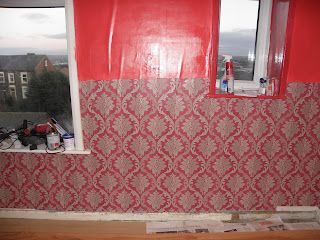No, not the anniversary of the death of Albert III the Pious of Bavaria-Munich, but Leap Year - a day that happens once every four years (or 1460 days).
Today started with a couple of hours on the ship. I'm building a model ship for the study, so whilst waiting for the postie, I spent some time on fitting the decks. Then I had a couple of hours sanding down some old furniture. Pictures of both activities will follow when the items are ready for the study.
I finally got the last strip of border up - to the left of the large window, then fitted the tie-back hook.
 |
| Curtain tied-back from the left side. |
I put the mouldings in place on The Stage.
I started French polishing the fireplace - the first couple of coats of maybe twenty or thirty. A separate post will detail French polishing - but it's a long, drawn out job.
I cut the mouldings for surrounding the fireplace with a mitre cutter. Here's a picture of a mitre cutter.
It may look like a medieval torture instrument, but once you get the hang of using it, it's the best way of cutting angles for wood. Don't forget that ninety degrees is an angle - so you can use a mitre cutter for straight cuts. Then I undercoated the mouldings with emulsion paint, ready for glossing tomorrow.
 |
| Mouldings masquerading as rhubarb... |
Finally, by way of an update, here's how the leather chair looks now. Still a long way to go, but already appreciably better.



















































